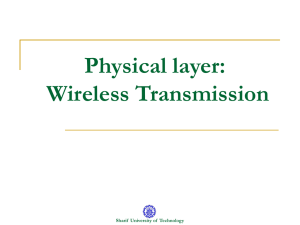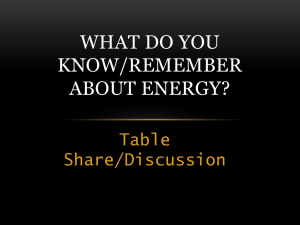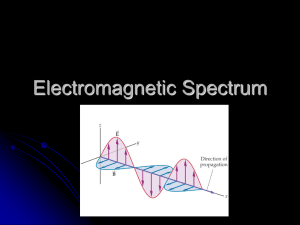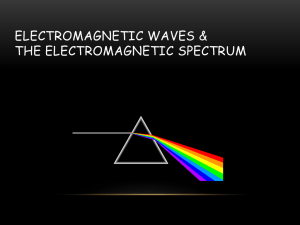The_Physical_Layer2
advertisement
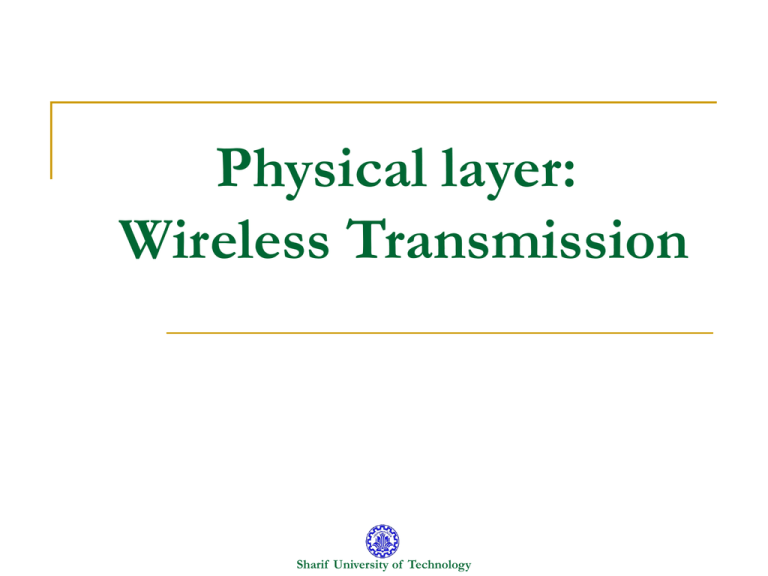
Physical layer: Wireless Transmission Sharif University of Technology Wireless Transmission Introduction Future communication Fiber optic for fixed systems Wireless for mobile systems Wireless has advantages for even fixed devices in some circumstances The Electromagnetic Spectrum When electrons move, they create electromagnetic waves that can propagate through space (even in a vacuum). When an antenna of the appropriate size is attached to an electrical circuit, the electromagnetic waves can be broadcast efficiently and received by a receiver some distance away. The fundamental relation between f, , and c (in vacuum) is: when l is in meters and f is in MHz,f 300. For example, 100-MHz waves are about 3 meters long, 1000-MHz waves are 0.3-meters long, and 0.1-meter waves have a frequency of 3000 MHz. The Electromagnetic Spectrum The radio, microwave, infrared, and visible light portions of the spectrum can all be used for transmitting information by modulating the amplitude, frequency, or phase of the waves The Electromagnetic Spectrum Relation between bit rate and bandwidth The amount of information that an electromagnetic wave can carry is related to its bandwidth. With current technology, it is possible to encode a few bits per Hertz at low frequencies, but often as many as 8 at high frequencies. Relation between wavelength band and frequency band Wide band transmission Most transmissions use a narrow frequency band to get the best reception Wide band Frequency hopping spread spectrum change frequencies hundreds of times per second security avoids multipath fading Example: 802.11,Bluetooth Wide band Direct sequence spread spectrum spread the signal over a wide frequency band used in cell phones: second and third generation mobile phones Radio Transmission Radio waves are easy to generate, can travel long distances, and can penetrate buildings easily, so they are widely used for communication, both indoors and outdoors. The properties of radio waves are frequency dependent. Low frequency penetrate buildings follow curvature of earth low bandwidth omnidirectional Higher frequencies straight line bounce off of obstacles absorbed by rain Radio Transmission • In the VLF, LF, and MF bands, radio waves follow the ground These waves can be detected for perhaps 1000 km at the lower frequencies, less at the higher ones (AM Radio) • In the HF and VHF bands, the ground waves tend to be absorbed by the earth. However, the waves that reach the ionosphere, a layer of charged particles circling the earth at a height of 100 to 500 km, are refracted by it and sent back to earth Microwave Transmission microwave communication is widely used for long-distance telephone communication, mobile phones, television distribution. microwaves travel in nearly straight lines can be narrowly focused much higher signal-to-noise ratio microwaves do not pass through buildings multipath fading absorption by water microwave communication is widely used for longdistance telephone communication, mobile phones, television distribution The Politics of the Electromagnetic Spectrum • National governments allocate spectrum for AM and FM radio, television, and mobile phones, as well as for telephone companies, police, maritime, navigation, military, government, and many other competing users •The ISM (Industrial, Scientific, Medical) bands in the United States Infrared and Millimeter Waves widely used for short-range they are relatively directional, cheap, and easy to build they do not pass through solid objects Lightwave Transmission Communication Satellites communication satellite can be thought of as a big microwave repeater in the sky. transponders each of which listens to some portion of the spectrum, amplifies the incoming signal, and then rebroadcasts it at another frequency to avoid interference with the incoming signal Communication Satellites Satellite Communication The principal satellite bands •A modern satellite has around 40 transponders, each with an 80-MHz bandwidth. • Nowadays, each transponder beam is divided into time slots, with various users taking turns •footprint and Spot beam Satellite Communication VSATs (Very Small Aperture Terminals new development in the communication satellite world is the development of low-cost microstations These tiny terminals have 1-meter or smaller antennas and can put out about 1 watt of power uplink is generally good for 19.2 kbps, but the downlink is more often 512 kbps or more. Hub : special ground station with a large, high-gain antenna is needed to relay traffic between VSATs Satellite Communication VSAT Terminals and Hub Satellite Communication Medium-Earth Orbit Satellites GPS (Global Positioning System) Low-Earth Orbit Satellites Iridium Globalstar Teledesic
